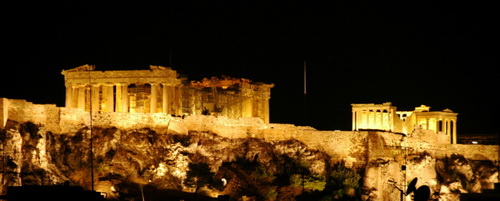
Now, a new book published by archaeologist and NYU professor Joan Breton Connelly entitled, “The Parthenon Enigma,” rocks the boat and involves even mummies in the building’s history.
As described by Connelly, the story begins in ancient Egypt. While the rulers were buried in gold sarcophagi, mere mortals were mummified with cheaper materials, mainly recycled papyrus that held early drafts of written works, including transcribed texts from ancient Greece.
When a Greek scholar examined scraps from one of these mummies, he discovered about 250 lines of the lost play Erechtheus, by the great Greek playwright of 5th century BC Athens, Euripides.
“These coffins end up being our best source of lost Greek texts,” said Connelly, who noted that the technology to remove the papyrus without destroying it did not exist until the 1960s. Papyrus fragments like the one found on the mummy helped crack the story behind the Parthenon.
According to Connelly, the play tells the story of the early king of Athens, Erechtheus. When his city was threatened by a rival, the oracle at Delphi said that the king should sacrifice his daughter in order to win the battle and save his city. After the sacrifice of his youngest daughter, the goddess Athena directed the king’s wife to honor the dead by building a sacred precinct on the Acropolis, which was given the name Erechtheion.
Connelly first learned of the play in the 1990s. “I realized that Euripides was talking about what you see in the middle of the Parthenon frieze,” she wrote in her book. “It’s a family group consisting of a mother, father and three girls, who are preparing to sacrifice the littlest girl.”
Connelly’s reinterpretation of the Parthenon frieze ultimately holds a positive message, one that is connected with the very nature of a civilized society, democracy, and how the Athenians were different from everyone else of their time.
“The message they chose to put above the door of their finest temple, their core belief was that no family, not even royalty can put themselves above the common good. It was a great embodiment of the notion of self-sacrifice. It’s the spiritual backbone of Athenian democracy,” she said.
Connelly sees the Parthenon and particularly the frieze as the ultimate expression of the Athenian belief in the power of democracy. “The Parthenon is the culmination of the 50 years that preceded it,” explaining that the Athenians had defeated a series of ruling tyrants and established a democracy in 508 BC.
“This was a young democracy that was really radical in terms of what other city-states were doing at the time, in the way they dispersed power and governance across the citizen body,” she said and added, “Even poorer people could vote in the citizens assembly. It was really incredible.”
The Parthenon was the physical manifestation of the city’s ideals.
“It gives us a visual expression of how the Athenians saw themselves. At the same time it was being expressed in the theater by great playwrights and philosophers. This was all a huge expression of what it meant to be Athenian [at that time].”
Apart from the small section of text found on the papyrus, Euripides’ play is lost to history. But Connelly’s theory is that the story; of a family willing to sacrifice their daughter for the greater good of Athens, was a parable and an idea deemed important enough in ancient Greece to adorn the building.
For a detailed analysis of the Parthenon frieze click here.
See all the latest news from Greece and the world at Greekreporter.com. Contact our newsroom to report an update or send your story, photos and videos. Follow GR on Google News and subscribe here to our daily email!



